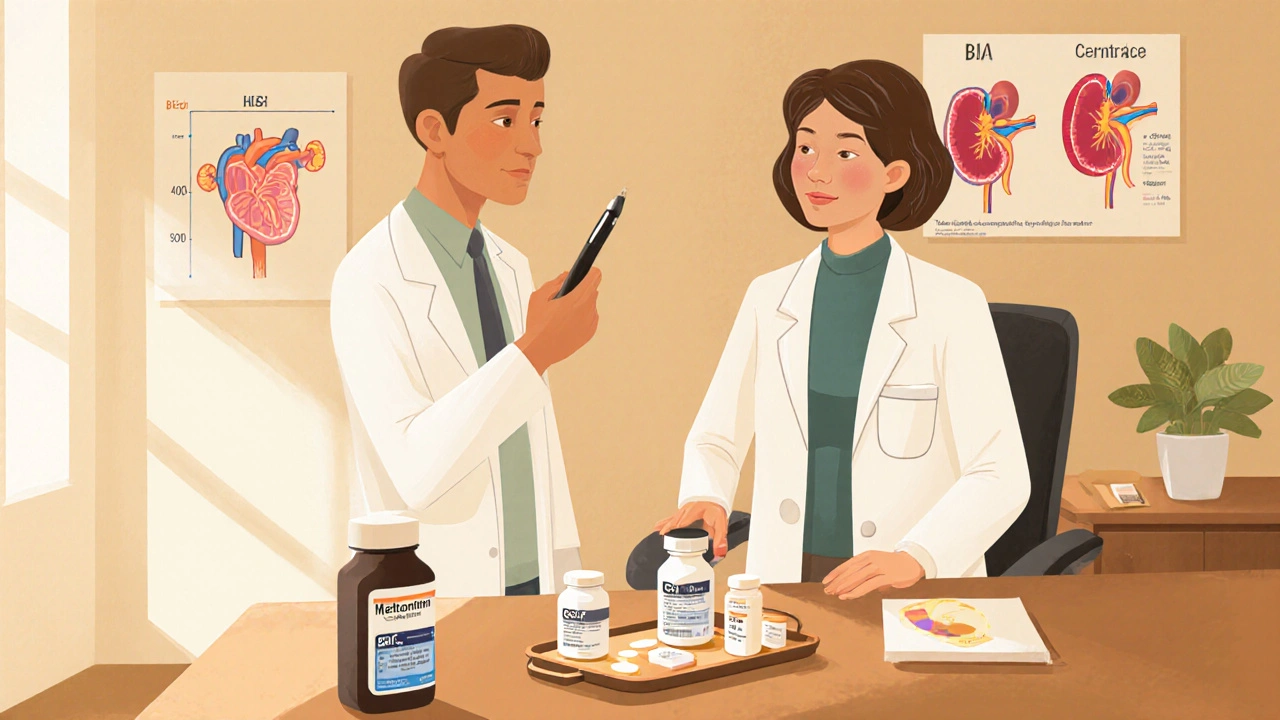Diabetes Medication Decision Tool
Recommended Medication Options
Metformin
First-line Cost-effective Weight-neutral
- Reduces HbA1c by 1-1.5%
- Minimal risk of hypoglycemia
- Low cost (~$2/month)
- May cause GI upset
GLP-1 Agonist
Weight loss CV protection Higher cost
- Reduces HbA1c by 1.5-2.0%
- Promotes weight loss
- Cardiovascular benefits
- Higher cost (~$400/month)
SGLT2 Inhibitor
Weight loss CV protection Higher cost
- Reduces HbA1c by 0.5-1.0%
- Promotes weight loss
- Cardiovascular benefits
- Risk of UTIs, genital infections
Sulfonylurea
Fast action Hypoglycemia risk Low cost
- Rapid blood sugar control
- Very low cost
- High risk of hypoglycemia
- Weight gain
Recommendation
When it comes to managing type 2 diabetes, Metformin is a biguanide oral drug that lowers blood glucose by reducing liver glucose production and improving insulin sensitivity. It’s been the first‑line choice for decades because it’s cheap, weight‑friendly, and has a solid safety record. But the market now offers a raft of newer agents - GLP‑1 agonists, SGLT2 inhibitors, DPP‑4 inhibitors, sulfonylureas, and thiazolidinediones - each with its own strengths and trade‑offs. If you’re weighing options for yourself or a patient, you need a clear side‑by‑side view.
Key Takeaways
- Metformin remains the most cost‑effective first‑line drug for most adults with type 2 diabetes.
- GLP‑1 agonists and SGLT2 inhibitors excel at weight loss and cardiovascular protection but cost more.
- Sulfonylureas work fast but carry a higher risk of hypoglycemia.
- Kidney function and gastrointestinal tolerance are the main clinical switches between Metformin and its alternatives.
- A personalized plan that blends lifestyle change with the right medication class yields the best HbA1c outcomes.
How Metformin Works (and Why It’s Popular)
Metformin’s primary actions are twofold: it suppresses hepatic gluconeogenesis and increases peripheral glucose uptake. The drug works without stimulating insulin release, which means the risk of low blood sugar is minimal. Typical dosing starts at 500mg once daily, gradually titrating to 1500‑2000mg split doses to improve tolerability.
Key benefits include:
- Average HbA1c reduction of 1‑1.5%.
- Neutral or modest weight loss (≈1‑2kg).
- Low cost (often <$0.10 per tablet in Australia).
- Potential cardiovascular benefit shown in the UKPDS trial.
Common side effects are gastrointestinal - nausea, bloating, and diarrhea - which can be mitigated by using extended‑release formulations or taking the drug with meals.
Alternative Drug Classes at a Glance
Below are the main alternatives you’ll encounter, each introduced with microdata for easy knowledge‑graph mapping.
GLP‑1 agonists are injectable or oral agents that mimic the hormone glucagon‑like peptide‑1, boosting insulin secretion, slowing gastric emptying, and promoting satiety. Examples: liraglutide, semaglutide.
SGLT2 inhibitors block the sodium‑glucose co‑transporter‑2 in the kidneys, causing excess glucose to be excreted in urine. Examples: canagliflozin, empagliflozin.
DPP‑4 inhibitors prevent the breakdown of incretin hormones, modestly increasing insulin release after meals. Examples: sitagliptin, saxagliptin.
Sulfonylureas stimulate pancreatic beta‑cells to release more insulin. Examples: glipizide, gliclazide.
Thiazolidinediones (TZDs) activate PPAR‑γ receptors, improving insulin sensitivity in fat and muscle. Example: pioglitazone.
Head‑to‑Head Comparison
| Attribute | Metformin | GLP‑1 Agonist | SGLT2 Inhibitor | Sulfonylurea | Thiazolidinedione |
|---|---|---|---|---|---|
| HbA1c reduction | 1‑1.5% | 1‑1.5% (plus weight loss) | 0.5‑1% | 1‑2% | 0.5‑1% |
| Weight effect | Neutral or slight loss | 5‑10% loss | 2‑4% loss | Weight gain | Weight gain |
| Cardiovascular benefit | Modest (UKPDS) | Strong (reduced MACE) | Strong (reduced HF hospitalization) | None | Neutral |
| Hypoglycemia risk | Very low | Low | Low | High | Low |
| Renal restriction | eGFR ≥30mL/min/1.73m² (dose adjust) | eGFR ≥30mL/min/1.73m² (some agents down to 15) | eGFR ≥45mL/min/1.73m² (some to 30) | eGFR ≥30mL/min/1.73m² | eGFR ≥30mL/min/1.73m² |
| Cost (AU$ per month) | ~10‑20 | ~300‑400 | ~200‑300 | ~30‑50 | ~50‑80 |
When Metformin Is the Clear Choice
- Newly diagnosed adults with HbA1c between 7‑9% and eGFR ≥30mL/min/1.73m².
- Patients who need a low‑cost regimen and are motivated to adopt diet/exercise changes.
- Those with a history of cardiovascular disease where modest benefit is acceptable.
- Individuals intolerant to injectable therapy.
Start with 500mg once daily, increase every 1‑2 weeks to the target dose. If gastrointestinal side effects appear, switch to the extended‑release formulation or split the dose.

When to Consider an Alternative First
Some clinical scenarios push you toward another class right away:
- Significant obesity (BMI≥30kg/m²): GLP‑1 agonists or SGLT2 inhibitors can deliver meaningful weight loss.
- Established heart failure or chronic kidney disease: SGLT2 inhibitors have proven mortality benefits.
- Rapid HbA1c drop needed (e.g., >2%): Sulfonylureas or combination therapy can achieve quick control.
- Pregnancy: Metformin is used off‑label, but insulin remains the gold standard; alternatives are rarely chosen.
- Intolerance to Metformin’s GI effects despite dose adjustments: Switch to a DPP‑4 inhibitor or low‑dose GLP‑1 agonist.
Practical Checklist for Clinicians
- Assess baseline HbA1c, weight, eGFR, and cardiovascular history.
- Discuss cost expectations and insurance coverage.
- Start with Metformin unless contraindicated (eGFR<30, severe GI intolerance, or lactate risk).
- If target HbA1c isn’t reached in 3‑6months, consider adding an agent based on the patient’s comorbidities.
- Re‑evaluate renal function every 6‑12months; adjust dose or switch class as needed.
- Educate patients on hypoglycemia signs, especially when using sulfonylureas.
Frequently Asked Questions
Can I take Metformin if I have kidney disease?
Metformin is safe down to an eGFR of 30mL/min/1.73m². Below that, the risk of lactic acidosis rises, so clinicians usually stop it or switch to an SGLT2 inhibitor if kidney function is 45‑60.
Why do some people lose weight on Metformin?
Metformin reduces appetite and improves insulin sensitivity, which can curb excess calorie storage. The average loss is modest (1‑2kg), but it’s enough to improve blood sugar control.
Are GLP‑1 agonists better than Metformin for heart health?
Large trials (LEADER, SUSTAIN‑6) show GLP‑1 agonists cut major adverse cardiac events by about 15‑20% in high‑risk patients, a benefit that Metformin only hints at.
What should I do if Metformin gives me diarrhea?
Try the extended‑release version, split the daily dose, or take the pill with food. If symptoms persist after two weeks, discuss switching to a DPP‑4 inhibitor.
Is it safe to combine Metformin with a sulfonylurea?
Yes, many guidelines recommend a Metformin‑sulfonylurea combo for stronger glucose lowering, but monitor for hypoglycemia and adjust sulfonylurea dose as needed.


Oh great another Metformin hype train.